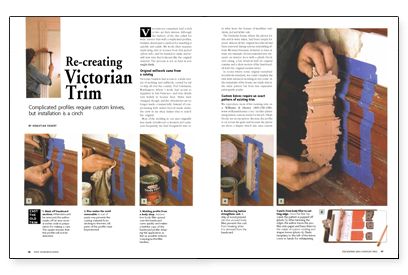Re-creating Victorian Trim
Complicated profiles require custom knives, but installation is a cinch.

Synopsis: The author, owner of an architectural millwork shop, explains how to duplicate complex Victorian-era trim that is no longer available commercially. He also describes the process of making plinth blocks and rosettes.
Victorian-era carpenters had a trick or two up their sleeves. Although the fashion of the day called for wide interior trim with complicated profiles, builders developed a method for installing it quickly and easily. My work often requires replicating trim in houses from that period, and I’ve learned to make and install new trim that looks just like the original material. The process is not as hard as you might think.
Original millwork came from a catalog
Victorian builders had access to a wide variety of molding and millwork, carried by rail or ship all over the country. Port Townsend, Washington, where I work, had access to suppliers in San Francisco, and trim details vary widely in houses here. Styles have changed, though, and the old patterns are no longer made commercially. Instead of compromising with newer factory-made styles, the crew in my shop makes trim to match the original.
Most of the molding in our area originally was made of redwood or western red cedar. Less frequently, we find Douglas-fir trim or, in what were the homes of wealthier residents, red and white oak.
The Trenholm house, where the photos for this article were taken, had been empty for years. Almost all the original woodwork had been removed during various remodeling efforts. We were fortunate, however, to have at least one example of every essential trim element: an interior door with a plinth block and casing, a bay window with its original rosettes and a short section of the baseboard, all with the original varnish intact.
In rooms where some original varnished woodwork remained, we could complete the trim with identical molding in red cedar. In the remainder of the house, we made trim in the same pattern but from less expensive paint-grade poplar.
Custom knives require an exact pattern of existing trim
We reproduce most of the running trim on a Williams & Hussey (www.williamsnhussey.com) molder-planer using knives custom-made for the job. Plinth blocks are an exception: Because the profile is cut across the grain and because the pieces are short, a shaper, which also uses custom knives, works best.
A sharp outline of existing trim is critical in getting accurately profiled knives. When I’m working with a scrap piece of trim — one that has already been removed — I carefully strip off any layers of paint and finish without destroying the shape. Then I make a fresh perpendicular cut at the end and trace the profile onto a piece of paper. Plinth blocks can be traced in place this way.
For more photos and details, click the View PDF button below:


























